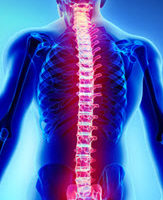Social Security and Evidence of Disorder of the Spine and Major Dysfunction of a Joint

If you have a spine injury or major dysfunction of a joint, you are not alone. In fact, according to World Spine Day, lower back pain is the leading cause disability worldwide. 80 percent of Americans will develop back pain at some point in their lives. Back pain is the leading cause of missed work days in the U.S. Those who suffer from major dysfunctions of one or more joints, such as debilitating arthritis in the hands, face a similar set of problems. One of the single most important steps to take in order to remain as self-sufficient as possible is to file for Social Security benefits. SSD benefits are made possible by wage taxation that we all pay into over our lifetimes, and these benefits are available for everyone who has worked long enough and recently enough, regardless of age if under the age of retirement, and for those who meet the particular medical qualifications set by the Social Security Administration (SSA). Similarly, SSI benefits are paid to those below the financial threshold and who, like SSD, are unable to work. To learn more, you need to contact a qualified West Palm Beach disability attorney.
Disorders of the Spine
In order to qualify for Social Security benefits, you and your attorney must be able to provide competent substantial evidence through a physician’s opinions that your spine disorder is substantial. Examples of spinal disorders include herniated nucleus pulposus, spainl arachnoiditis, spinal stenosis, osteoarthritis, degenerative disc disease, facet arthritis, and vertebral fracture, resulting in compromise of a nerve root (including cauda equina) or the spinal cord. Under Listing 1.04 of the Social Security Administration, evidence of a disorder of the spine must also include the following:
A.
- Nerve root compression characterized by neuro-anatomic distribution of pain;
- Limitation of motion of the spine;
- Motor loss (atrophy with associated muscle weakness or muscle weakness);
- Sensory or reflex loss; and
- (if involvement in the lower back) A positive straight-leg raising test (sitting and supine). OR
B.
- Spinal arachnoiditis manifested by severe burning or painful dysesthesia, resulting in the need to change positions more than once every 2 hours. OR
C.
- Lumbar spinal stenosis resulting in pseudoclaudication manifested by chronic nonradicular pain and weakness, resulting in the inability to ambulate effectively.
Major Dysfunction of a Joint
A major dysfunction of one or more joints must also be shown by competent substantial evidence through a physician’s medical opinions. Joint dysfunction must be characterized by a gross anatomical deformity (e.g. subluxation, contracture, bony or fibrous ankylosis, instability), and chronic joint pain and stiffness, with limited or abnormal motion, and joint space narrowing, bony destruction, or ankylosis of the affect joint. Evidence of a major dysfunction must also include the following:
- Involvement of one major peripheral weight-bearing joints (i.e. hip, knee, or ankle) that results in an inability to ambulate effectively; OR
- Involvement of one major peripheral joint in each upper extremity (i.e. shoulder, elbow, or wrist-hand) that results in an inability to perform fine gross movements effectively.
A West Palm Beach Social Security Attorney is Here to Help
It is advisable that you secure the services of an experienced Social Security attorney to secure benefits. We urge you to call the attorneys at Celeste Law Firm.
Resource:
worldspineday.org/resources/spinal-health-and-spine-disorders/

